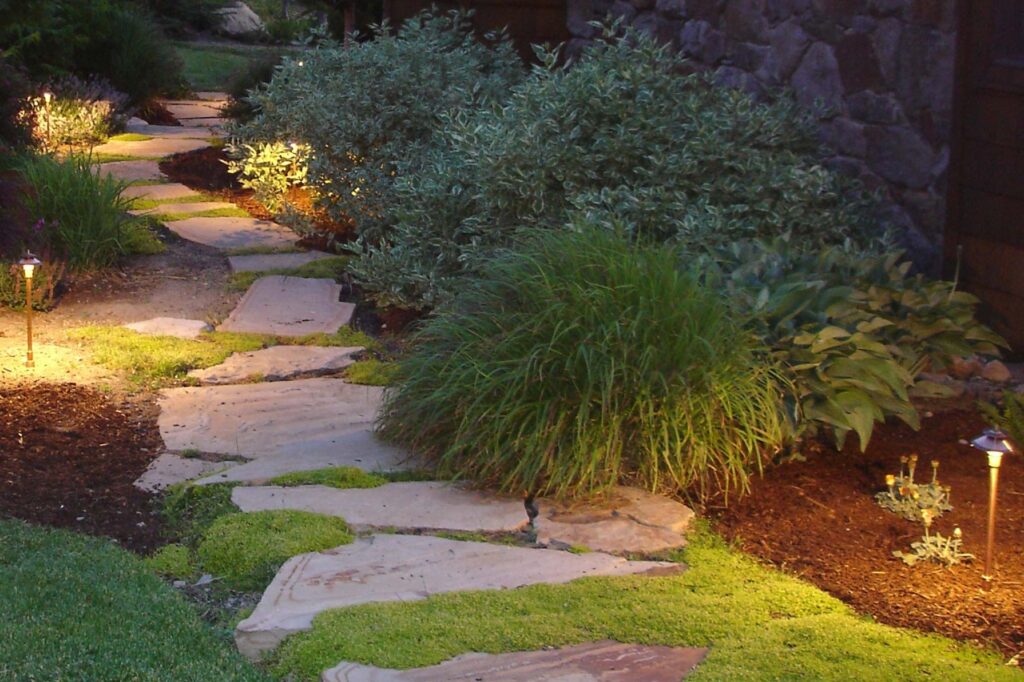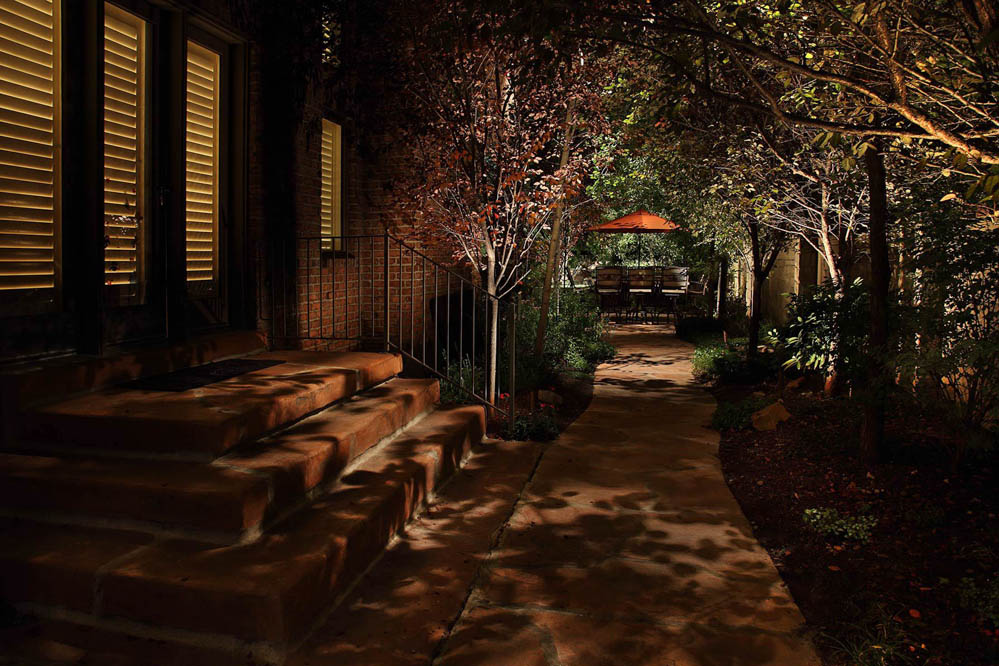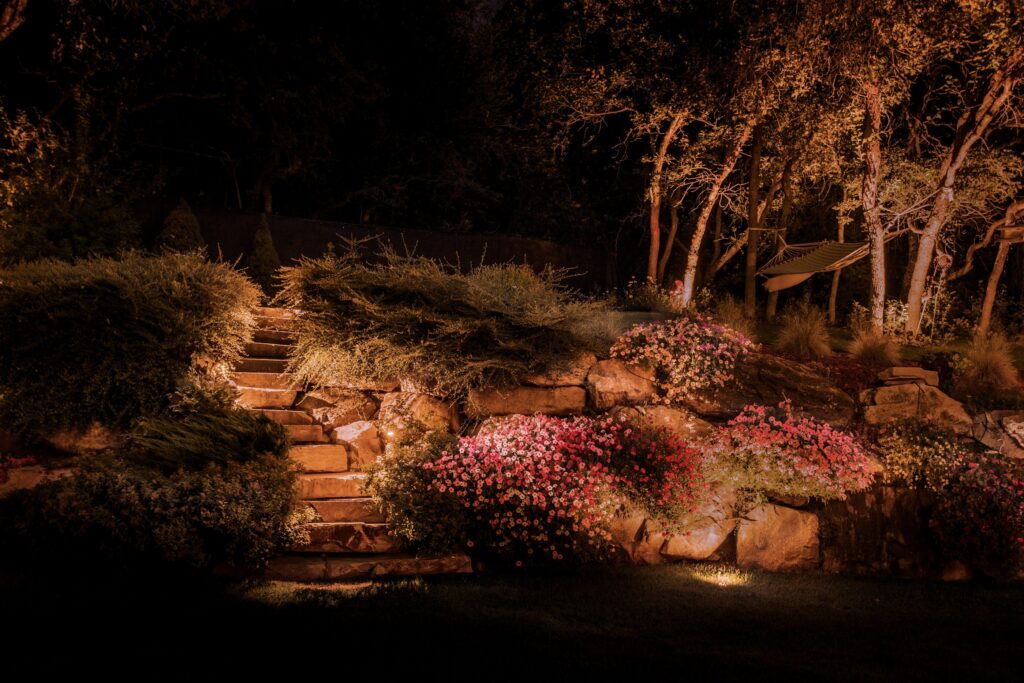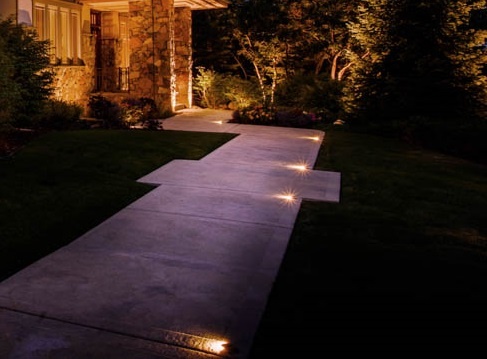4 Path Lighting Design Ideas [Guide to low Voltage Path Light Categories]
There are numerous ways outdoor path lighting design can be approached and categorized. The key to understanding which path light categories will work well for you is learning how to recognize what will work best for the way you intend to use your pathway at night. There are positive and negative aspects to each pathway light design concept. Our hope is that this brief guide will help you understand how artistic pathway lighting isn’t about fixtures, it’s about design.
Pathway Lighting Design Approaches
1. The Traditional Path Light
Your typical low voltage path light is made up of two parts: a post and a top hat. While there are countless variations of this fixture, from contemporary bollards to whimsically sculpted fixtures in the shape of flowers, these fixtures all perform similarly in that they are used along pathways to direct light downward onto the path for people to see their way at night. You’ve likely seen these fixtures lining people’s driveways or the path leading up to their front door.

- Pros: One great aspect to these fixtures, and likely the reason why we see them so often, is their versatility. Traditional path lights can be used to illuminate the majority of the paths we see in today’s modern landscapes.
- Cons: These fixtures are more vulnerable to damage then just about any other fixture in the landscape. They can also potentially cause a hazard in high traffic areas if the fixture isn’t placed strategically. While these fixtures aren’t built from any magnetic materials I’m aware of, their ability to attract balls thrown or kicked by children is truly remarkable. Be mindful that if you have children, it may be worth exploring other options for lighting your path.
- Tips: We have two tips when it comes to traditional path lights. Avoid placeing a traditional path light in a turfed area. Lawnmowers, edgers, and trimmers tend to be unforgiving. Placing a path light in a lawn is not unlike parking a car in the middle of an interstate. It just won’t end well.
Traditional path lights are one of the most abused and misused fixtures in the landscape. By misused, I simply mean they are used in ways that don’t make sense. It makes sense to use path lights in a planter bed next to a pathway. It doesn’t make sense to use a path light in a flowerbed where there isn’t a path. The trick to good lighting design is lighting with purpose, not at random.
2. Moon Lighting
Moon lighting, also referred to as down lighting, is used to bathe an area in the landscape with a soft light from above. Essentially, a down light is a fixture mounted up high, in a tree or from the soffit of someone’s home, and aimed downward to cast a soft light over the target that creates an effect similar to moonlight. Down lights make for a great path lighting approach because they allow you to cover a large area of the path, potentially use less fixtures, and create a beautiful effect.

- Pros: Down lighting makes for beautiful functional light. The fixtures are up high and out of danger of being harmed by a stray ball. In the above picture, one of the homeowner’s primary concerns was that their three boys would damage any path lights on the ground. Down lighting was the perfect solution for their situation.
- Cons: Down lighting requires an elevated platform. Tall established trees or a tall building directly next to the path is needed for the fixtures to be mounted up high. Areas in the landscape that do not have established trees simply will not facilitate down lighting since there is no where to place the light. In addition, down lighting can require a careful eye that knows where best to place the fixture in the tree to get the most desirable effect. If the light is placed in a spot where a branch will end up obscuring half the light, for example, the down light will be rendered nearly useless.
- Tips: Mounting a down light up high is the key to creating a beautiful effect and avoiding the potential for people to notice glare. When we say glare, we are referring to the light source inside the fixture. In artistic landscape lighting, the goal should be to see the effect the light is creating, but not the source. Mounting a down light up high is ideal because it helps remove the fixture from people’s line of sight. Beautiful down lighting can require a lot of careful thought. Its always a good idea to consult with a local lighting designer is you’re unsure about moon lighting.
3. Directional Path Light
A directional path light is similar to a traditional path light with one exception: a directional path light can be adjusted to change the direction the light is being directed. As where a traditional path light has a top hat, a directional path light has a directional head that can be swiveled and adjusted.

- Pros: Directional path lights are great for above grade applications. If traditional path lights had been used to illuminate the stone steps in the above photo, we would see glare from the fixtures. But with directional path lights, the glare is limited because the angle the light can be adjusted to shield the light from our eyes. Directional path lights give you lots of control over the effect the light is creating.
- Cons: These fixtures can sometimes need to be readjusted. They aren’t the best for washing a broader area with light. They’re best used when there is a need for something directional.
- Tips: Be mindful of what kind of lamp you have in this fixture. Just because the fixture is accommodating to a larger bulb doesn’t mean it needs a larger bulb with more power. Less is more.
4. Non Traditional Path Lights
There are numerous ways a path way can be illuminated. The biggest factors are the location of the path and the surrounding terrain. For instance, what do you do when a path runs straight through the middle of a turfed area (where traditional path lights should be avoided) and there are no established trees or tall structures near by for moon lighting? These situations are where lighting designers have the most fun getting creative with their design.

Like we just said, there are numerous ways a path can be lit effectively. For this example of a non traditional path light, we are going to discuss recessed path lights. But remember, there are countless ways a path could be lit non traditionally. This is just one example.
- Pros: A recessed path light is a non traditional path lighting approach that isn’t seen too often. Especially when the fixture is recessed directly into the cement path itself. That said, it is an effective solution for spilling light out over a path when there are few other alternatives. As a marker light that helps establish where the edge of the path is, this approach excels. It allows you to see the path while also defining the edge.
- Cons: This fixture doesn’t distribute as much light over the path as a traditional path lighting fixture would.
- Tips: Pay attention to the surroundings and the direction the fixture will be facing. It is difficult to tell in the above picture, but the lawn to the right of the path slopes down to create a small hill before it meets the road. If the fixtures had been installed on the other side of the path facing away from the house, the light would have been directed out at the road where it would have been an eye sore.
As you can imagine, the fixtures in the picture above are not simple to install. Expensive equipment and a real understanding of how to use that equipment are required to install something like this. But that is besides the point. The reason this design approach is included here isn’t because it’s ‘fancy lighting’. We included it because it demonstrates creative lighting design.
Conclusion:
When it comes to low voltage path lights, consider these three things: Design with light rather than fixtures; consider the variables involved around the path; don’t be afraid to get creative and have fun.
Landscape Lighting Makes All the Difference
At Landscape Lighting Pro of Utah, the art of outdoor illumination is a real passion we work to perfect. Designing elegantly bespoke landscape lighting systems is simply all we do. For over 15 years, our award winning team of designers and craftsmen have striven to bring the best outdoor lighting experience possible to people’s homes and businesses across the Wasatch Front and beyond.
Located in Midvale, Landscape Lighting Pro of Utah installs, maintains, and repairs lighting systems throughout Utah’s residential areas, including Salt Lake City, Park City, Draper, Davis, and Utah Counties.
If you have an upcoming project you’d like help with, call us at (801) 440-7647 for more information, schedule a free consultation, or feel free to simply fill out a contact form.
Salt Lake City (Midvale)
801-440-7647
St. George
435-932-6627
©2025 Landscape Lighting Pro
Privacy Policy
Cookie Policy